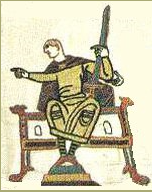
Hugh Capet was the King of the Franks from 987 to 996. He is the founder of and first king from the House of Capet. The son of the powerful duke Hugh the Great and his wife Hedwige of Saxony, he was elected as the successor of the last Carolingian king, Louis V. Hugh was descended from Charlemagne's son Pepin of Italy through his mother and paternal grandmother, respectively, and was also a nephew of Otto the Great.

Adbelahide, Adele, Adela or Adelaide of Aquitaine, was Queen of France by marriage to Hugh Capet, King of the Franks. Adelaide and Hugh were the founders of the Capetian dynasty of France, which would rule France until the 18th and 19th centuries. As queen consort, Adelaide had some extent of influence over her husband's governance of France. Adelaide is typically only briefly mentioned in connection to her husband, Hugh, and her son Robert II.

Charles was the duke of Lower Lorraine from 977 until his death.
William IV Talvas was William III, Count of Ponthieu and William IV. He was Count of Ponthieu, ruler of a small province in northern France that fell under the suzerainty of the dukes of Normandy since at least the mid 11th century.

William III of Ponthieu also called William Talvas. He was seigneur de Montgomery in Normandy and Count of Ponthieu.

Guy I of Ponthieu was born sometime in the mid- to late 1020s and died 13 October 1100. He succeeded his brother Enguerrand as Count of Ponthieu.
Agnes of Ponthieu was ruling Countess of Ponthieu from 1100.
Hugh II of Ponthieu was count of Ponthieu and lord of Abbeville, the son of Enguerrand I of Ponthieu. Evidently, Hugh II was the half-brother of Guy, who became the bishop of Amiens; Fulk, who became the abbot of Forest l'Abbaye; and Robert. However, it is possible that both Robert and Hugh II were the sons of Enguerrand's first wife, and Guy and Fulk the sons of a later wife that Enguerrand I married when he was in his forties.
Enguerrand I was the son of Hugh I of Ponthieu and Gisela, daughter of Hugh Capet.
Guy II of Ponthieu was the son of William III of Ponthieu and Helie of Burgundy.

The County of Ponthieu, centered on the mouth of the Somme, became a member of the Norman group of vassal states when Count Guy submitted to William the Conqueror, Duke of Normandy after the battle of Mortemer. It eventually formed part of the dowry of Eleanor of Castile and passed to the English crown. Much fought-over in the Hundred Years' War, it eventually passed to the French royal domain, and the title Count of Ponthieu became a courtesy title for the royal family.
Adalbert I of Vermandois, was the son of Herbert II of Vermandois and Adela of France. Born about 915, he succeeded his father as Count of Vermandois in 946.
Beatrice of Vermandois was a Carolingian aristocrat, queen of Western Francia by marriage to Robert I, and mother of Hugh the Great.
The Robertians are the proposed Frankish family which was ancestral to the Capetian dynasty, and thus to the royal families of France and of many other countries. The Capetians appear first in the records as powerful nobles serving under the Carolingian dynasty of Charlemagne in West Francia, which later became France. As their power increased, they came into conflict with the older royal family and attained the crown several times before the eventual start of the continuous rule of the descendants of Hugh Capet.

Gisèle of France was the daughter of Hugh Capet and Adelaide of Aquitaine. She married Count Hugh I of Ponthieu around 994. Gisela's children by Hugh included:

Helie of Burgundy was the daughter of Odo I, Duke of Burgundy and Sibylla of Burgundy, Duchess of Burgundy.

The Battle of Mortemer was a defeat for Henry I of France when he led an army against his vassal, William the Bastard, Duke of Normandy in 1054. William was eventually to become known as William the Conqueror after his successful invasion and conquest of England.

Baldwin II of Boulogne was a son of Arnulf III, Count of Boulogne, whom he succeeded as count of Boulogne.
Hilduin I, Count of Montdidier. It is unknown who the parents of Hilduin were. Hilduin was the founder of the House of Montdidier, which produced the Counts of Montdidier, Dammartin and Roucy.

The Montgomery family or de Montgomerie is a prominent family of Anglo-Norman origin, belonging to both French and British nobility. At the turn of the 12th century, the family was one of the leading families, with Robert de Bellême being the wealthiest and most powerful magnate in England and Normandy. The House was succeeded by the House of Belleme.









